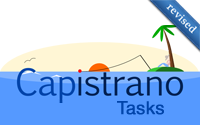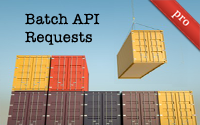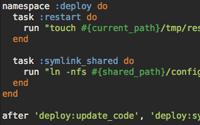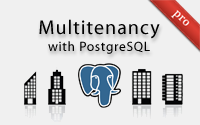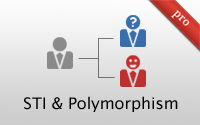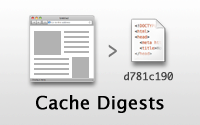Categories
- Active Record
- Active Resource
- Active Support
- Administration
- Ajax
- APIs
- Authentication
- Authorization
- Background Jobs
- Caching
- Code Walkthrough
- Controllers
- Debugging
- Deployment
- eCommerce
- Forms
- Mailing
- Models
- Performance
- Plugins
- Production
- Rack
- Rails 2.0
- Rails 2.1
- Rails 2.2
- Rails 2.3
- Rails 3.0
- Rails 3.1
- Rails 3.2
- Rails 4.0
- Refactoring
- Routing
- Search
- Security
- Testing
- Tools
- Views
Applied Filters:
task x
Capistrano Tasks (revised)
Learn the basics of writing Capistrano tasks, how to set variables, and run commands on a remote server. Then peak into the internals of Capistrano's deploy tasks to see how they work.
(10 minutes)
Deploying to a VPS
Deploying a Rails application can be overwhelming because there are so many different options. Here I present a pattern for deploying a Rails app to a VPS using nginx, Unicorn, PostgreSQL, rbenv and more.
(18 minutes)
Batch API Requests
Here I demonstrate how to perform bulk API operations though a single request using Rack middleware. This is great if you need to trigger multiple actions at once such as if the user goes offline.
(18 minutes)
jQuery & Ajax (revised)
Here I go back to the basics and show how to turn a traditional Rails app into one that interacts through Ajax by adding "remote" options, JavaScript templates and a dabble of jQuery.
(14 minutes)
Capistrano Tasks
Do you know how to make Capistrano tasks? See how to change default deployment behavior with custom tasks in this episode.
(8 minutes)
Multitenancy with PostgreSQL
PostgreSQL Schemas can help create a multi-tenant app by keeping data separate at the database layer. Integrating with migrations can be tricky though, so watch this episode for the full details.
(11 minutes)
Turbolinks
Turbolinks can make your Rails app feel faster by using JavaScript to replace the page content when clicking a link. It will be default in new Rails 4.0 applications, but here I show how to use it in Rails 3 and mention some of the gotchas.
(7 minutes)
STI and Polymorphic Associations
Single Table Inheritance (STI) can help organize branching logic into separate classes, but a polymorphic association may be a better fit if there are unique database columns.
(14 minutes)
Guest User Record
Instead of presenting a sign up form to the user, consider creating a temporary guest record so the user can try out the application without filling in their information up front. They can then become a permanent member afterwards.
(9 minutes)
Cache Digests
The cache_digests gem (also included in Rails 4) will automatically add a digest to the fragment cache key based on the template. If a template changes the cache will auto-expire. But watch out for the gotchas!
(7 minutes)

